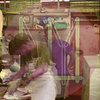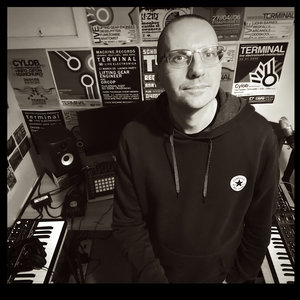Gagarin by Stereo Minus One

As a Bandcamp-only release, we're adding the tracks from Stereo Minus One's recent set as part of More Kicks Than Friends: The Wales Edition, which was live-streamed on YouTube on 13 April 2024.
Tom Wallace (aka Pope Jean Paul Van Damme) did an amazing job pulling this live-stream together for Ned Rush's YouTube channel. It also included new music from label regulars Lifting Gear Engineer, and John Barnes, as well as a host of other Welsh talents.
Another highlight was the inclusion of two fantastic features on the Welsh electronic music scene - one on the Wales Electronic Producers Network (WEPN) and one on Machine Records. Links below:
More Kicks Than Friends: The Wales Edition livestream:
www.youtube.com/live/Dy0Gwzaoglg?si=TyHwN8KQ_8UNRPx4
Machine Records feature:
youtu.be/JTaASqSs9Zo?si=X0Lwj4_jkWxbbJog
Getting back to this release, we talked to Stereo Minus One aka Dan Haines Cohen about how he made the tracks for his set.
Machine: These tracks are a bit different to recent music you have released, such as last year's album 'Everything Is So Beautiful, I Need To Lie Down'. Can you tell me a bit about how you approached them?
Dan: The brief from Tom was 20 minutes of new music, with quite a short timeframe compared to how I normally work, which is very slowly! I knew I wanted to make something that acknowledged the context in which it would first be heard, via a live-stream on YouTube, which is a new thing for me to be involved in.
The concept of the channel, 'More Kicks Than Friends' also made me interested to explore some more beat-driven music than I had done in a while. And it set me thinking about friendships, loneliness, and mental health.
That led me in a few different directions in terms of sounds and textures I wanted to create. The idea of a live-stream to me connected to that idea of a radio broadcast, even though of course YouTube is not really the same thing. As a kid, something I loved to do and which I'm sure shaped or warped my tastes for life was to tune between stations on AM frequencies, picking up noise and different voices that would merge into these amazing fugues. But also just tuning and finding something unknown and staying with it for a while, seeing what you might hear next, with a feeling anything could happen.
Often these would be French radio stations and I had no idea what they were saying but late at night it was hypnotic. It also led to me thinking about how those mistuned radios are like 'hearing voices' and to the dehumanising way people with mental health issues have been treated in the past, and continue to be stigmatised today. I've seen close friends struggle with this, in really serious ways, and poignancy of the 'More Kicks Than Friends' idea just took me in that direction.
Machine: Related to that, what is the footage in the visuals you made to go along with this music?
Dan: It's from a 1940s video made in an asylum. Each of them is meant to be illustrating a different diagnosis. I find these images heart-breaking, but they are also so odd that of course it is hard not to find them funny at times. I love that despite it all you can see their humanity and often their joy, as well as considerable despair.
These images reflect so much unease and confusion. The odd attempt to protect people's identities by partly covering their faces coupled with them being paraded about, and literally pushed and pulled around, is pretty intense and contradictory, I think. As far as I understand it, many of these people and others like them were probably misdiagnosed and many they would have been institutionalised their whole lives without good reason for the most part.
Machine: It's good to see some of this being challenged in recent times with the growing understanding of mental health and neurodiversity but the stigma is still strong.
Dan: Yes, there's a long way to go still. People pretend it is a minority and nothing to do with them, but we all know people who are struggling with these issues and struggling to get the help they need. As well as the visuals, some of the voices you hear in the tracks are taken from a more recent 1970s documentary about mental illness. At that time, they at least had begun to understand that people with mental illness deserve the same respect as anyone else, but the documentary is still mostly made up of doctors talking about these inpatients in a very dehumanising and scaremongering way.
They were all kinds of abusive treatments like ECT and lobotomies going on. Shocking numbers of people were incarcerated in this way, often with nothing we'd recognise today as a mental illness. I saw this absolutely shocking documentary about how in the 1960s, thousands of women were locked up in asylums in the UK simply for seeking abortions.
Another sonic layer of the tracks is taken from enthusiast recordings I found online of different types of radio interference patterns. Basically guys who are recording and sharing short recordings of interesting noises they picked up on amateur radio equipment. I found all these truly amazing noise sounds catalogued and presented with explanations of what might have caused the specific noise patterns. These are layered throughout these tracks.
Machine: How about the rest of what we are hearing - how was that made?
Dan: It's a mix of things. Some of it is analogue synths and drum machines, some of it is via Ableton instruments. I made extensive use of a Push 2 in making these tracks as well as a Novation Circuit and a Bass Station 2 and a poly-synth. On 'Poison in my Tea' I used a sample of a drum loop, but the rest of the drums are all designed and written from scratch which is how I usually work. In recent years I’ve been enjoying using more analogue gear and working 'hands-on' but I still make heavy use of Ableton and the computer in everything I do.
I don't generally use any samples and I avoid huge sound libraries as it's all just too overwhelming, the choices are paralysing. I keep the range of effects pretty simple for the same reason. I often start with very simple sound, literally just a single note, and try to use a basic palette of effects like delays and reverb to coax something interesting from them. Something you can hear on 'Gagarin' is me experimenting with bit reduction, which I've become a bit obsessed with again recently. (My 2005 album 5.wav is 8-bit).
Machine: What's next for Stereo Minus One?
Dan: I have some ideas underway, which will be the basis for a new album, but it's at an early stage. Working on these tracks as well as working with Veins Full Of Static on mastering his upcoming album and before that with Tom [Pope John Paul Van Damme] on mastering his album has been keeping me pretty busy lately.
Where I have had some time I've been experimenting with some more conventional approaches than usual, but trying to negotiate 'what I do' to fit within those more. I'm interested to make something that is more centred in recognisable ideas of beauty and a fuller expressivity than I've done previously.
This is something I started to explore more on 'Everything Is So Beautiful, I Need To Lie Down', and seeing the response to the tracks like 'Everybody's Talking At Me', 'I've Lost My keys', and 'Invasion' - has encouraged me to go further in that direction for my next album.
Tracklist
| 1. | The Face Of The Moon | 1:36 |
| 2. | Poison In My Tea | 4:02 |
| 3. | Descending From The Cross | 5:01 |
| 4. | Gagarin | 4:51 |
| 5. | Come Back From The Dead | 4:30 |
| 6. | Continuous mix | 20:00 |
Credits
Made by Dan Haines Cohen.







